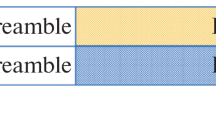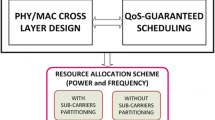Abstract
Orthogonal frequency division multiple access (OFDMA) has been adopted as the core physical layer access for a few broadband wireless access networks such as worldwide interoperability for microwave access (WiMAX). In WiMAX the primary concern is quality of service (QoS) support which aims to satisfy the diverse service requirements and to guarantee the required data rates from the available resources. Therefore, designing resource allocation algorithm becomes vital to maximize spectral efficiency. In this paper, two resource allocation algorithms are proposed, namely, weighted-rate adaptive slot allocation (WASA), and feedback delay-based slot allocation (FDSA) for OFDMA downlink system. The aim is to improve system performance by exploiting the available resources in a two-dimensional domain, and assigning the capacity for each user based on their achievable data rates and channel responses. During all these processes, fairness for all service types is ensured. Both approaches allocate appropriate resources and provide higher data rates for different service types by employing a weighted-rate factor and feedback information delay which are made to be greater than the minimum QoS requirements. Simulation results indicate that both WASA and FDSA achieve significant performance improvements in terms of spectral efficiency, outage probability, and fairness against the conventional OFDMA-TDMA and MAX-SNR algorithms. Comparison with recent works developed as adaptive slot allocation and reservation-based slot allocation has also been performed. The performance gains of both our proposed algorithms can be attributed to satisfying of the diverse multiuser and QoS requirements.








Similar content being viewed by others
Explore related subjects
Discover the latest articles, news and stories from top researchers in related subjects.References
IEEE Std 802.16e. (2006). IEEE Standard for local and metropolitan area networks. Part 16: air interface for fixed and mobile broadband wireless access systems.
Prasad, R. (2004). OFDM for wireless communications systems.
IEEE 802.16m. (2010). IEEE Draft Amendment Standard for Local and Metropolitan Area Networks. Part 16: Air Interface for Broadband Wireless Access Systems–Advanced Air Interface, D10, p. 1–1132.
Keller, T., & Hanzo, L. (2000). Adaptive modulation techniques for duplex OFDM transmission. IEEE Transactions on Vehicular Technology, 49(5), 1893–1906.
Zhang, Y., & Leung, C. (2009). Cross-layer resource allocation for real-time services in OFDM-based cognitive radio systems. Telecommunication Systems, 42(1–2), 97–108.
Song, G., & Li, Y. (2005). Cross-layer optimization for OFDM wireless networks-part II: Algorithm development. IEEE Transactions on Wireless Communications, 4(2), 625–634.
Rong, B., Qian, Y., & Lu, K. (2007). Integrated downlink resource management for multiservice WiMAX networks. IEEE Transactions on Mobile Computing, 6(6), 621–632.
Femenias, G., Daobeitia, B., & Riera-Palou, F. (2012). Unified approach to cross-layer scheduling and resource allocation in OFDMA wireless networks. EURASIP Journal on Wireless Communications and Networking, 145, 1–19.
Tarhini, C., & Chahed, T. (2012). QoS-oriented resource allocation for streaming flows in IEEE802. 16e Mobile WiMAX. Telecommunication Systems, 51(1), 65–71.
Wang, H., & Dittmann, L. (2010). Downlink resource management for QoS scheduling in IEEE 802.16 WiMAX networks. Computer Communications, 33(8), 940–953.
Nguyen, T.-D., & Han, Y. (2006). A proportional fairness algorithm with QoS provision in downlink OFDMA systems. IEEE Communications Letters, 10(11), 760–762.
Ergen, M., Coleri, S., & Varaiya, P. (2003). QoS aware adaptive resource allocation techniques for fair scheduling in OFDMA based broadband wireless access systems. IEEE Transactions on Broadcasting, 49(4), 362–370.
Girici, T., et al. (2010). Proportional fair scheduling algorithm in OFDMA-based wireless systems with QoS constraints. Journal of Communications and Networks, 12(1), 30–42.
Gyasi-Agyei, A., & Kim, S.-L. (2006). Cross-layer multiservice opportunistic scheduling for wireless networks. IEEE Communications Magazine, 44(6), 50–57.
Choi, K. W., Jeon, W. S., & Jeong, D. G. (2009). Resource allocation in OFDMA wireless communications systems supporting multimedia services. IEEE/ACM Transactions on Networking, 17(3), 926–935.
Ali-Yahiya, T., Beylot, A.-L., & Pujolle, G. (2010). Downlink resource allocation strategies for OFDMA based mobile WiMAX. Telecommunication Systems, 44(1–2), 29–37.
Liu, Y., et al. (2010). A novel QoS-oriented packet scheduling algorithm for mixed services in the downlink of OFMDA system. In IEEE International Conference on Wireless Communications, Networking and Information Security (WCNIS).
Tarhini, C., & Chahed T. (2007). AMC-aware QoS proposal for OFDMA-based IEEE802. 16 WiMAX systems. In IEEE Global Telecommunications Conference (GLOBECOM’07).
Qiu, X., & Chawla, K. (1999). On the performance of adaptive modulation in cellular systems. IEEE Transactions on Communications, 47(6), 884–895.
Zhang, X., & Wang, W. (2006). Multiuser frequency-time domain radio resource allocation in downlink OFDM systems: Capacity analysis and scheduling methods. Computers & Electrical Engineering, 32(1), 118–134.
Aweya, J., Ouellette, M., & Montuno, D. Y. (2002). Stability and fairness of a rate allocation scheme. Telecommunication Systems, 20(3–4), 195–239.
Alsahag, A. M., et al. (2013). Fair uplink bandwidth allocation and latency guarantee for mobile WiMAX using fuzzy adaptive deficit round robin. Journal of Network and Computer Applications.
Reklaitis, G., Ravindran, A., & Ragsdell, K. (1983). Engineering optimization methods and applications. New York: Wiley.
Jain, R., Chiu, D.-M., & Hawe, W. R. (1984). A quantitative measure of fairness and discrimination for resource allocation in shared computer system. Hudson, MA: Eastern Research Laboratory, Digital Equipment Corporation.
Acknowledgments
The authors would like to acknowledge the Ministry of Higher Education of Malaysia for the partial financial support.
Author information
Authors and Affiliations
Corresponding author
Rights and permissions
About this article
Cite this article
Alsahag, A.M., Ali, B.M., Noordin, N.K. et al. Maximum rate resource allocation algorithms with multiuser diversity and QoS support for downlink OFDMA based WiMAX system. Telecommun Syst 63, 1–14 (2016). https://doi.org/10.1007/s11235-015-9967-y
Received:
Accepted:
Published:
Issue Date:
DOI: https://doi.org/10.1007/s11235-015-9967-y




